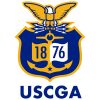Gregory J. Hall, Ph.D., Captain, USCG (Permanent Commission Teaching Staff)
 Captain Hall serves as the Vice Provost for Research and Professor of Chemistry at the U.S. Coast Guard Academy where he is the senior member of the Permanent Commissioned Teaching Staff (PCTS). He earned a B.S. in Marine Science from the Coast Guard Academy in 1995, and later earned an M.S. and Ph.D. in Chemistry from Tufts University.
Captain Hall serves as the Vice Provost for Research and Professor of Chemistry at the U.S. Coast Guard Academy where he is the senior member of the Permanent Commissioned Teaching Staff (PCTS). He earned a B.S. in Marine Science from the Coast Guard Academy in 1995, and later earned an M.S. and Ph.D. in Chemistry from Tufts University.CAPT Hall’s operational assignments include as Operations Officer of a sea-going buoy tender and as a hazardous materials response officer. CAPT Hall joined the faculty of U.S. Coast Guard Academy in 1999 and was selected to the PCTS later that year. CAPT Hall’s leadership assignments at the Academy have included Chemistry Section Chief, Senior Associate Dean, Chair of the Marine and Environmental Sciences Program, and Chair of the Academy’s regional accreditation process.
Captain Hall’s research focuses on the fingerprinting and weathering dynamics of pollutants in the environment. He serves on the science and technology subcommittee of the National Response Team, and is the Human Research Subjects Protection Program Director for the Academy. During the pandemic CAPT Hall served as the Director of the Academy’s disease surveillance program, where he and his team developed and deployed both individual and wastewater surveillance techniques which were broadly adopted by the wider Coast Guard. Captain Hall’s awards include the Meritorious Service Medal (2), Coast Guard Commendation Medal and Coast Guard Achievement Medal and he was awarded the Distinguished Faculty Award in 2021.
Education
- Ph.D. Chemistry, Tufts University, 2006
- M.S. Chemistry, Tufts University, 1999
- B.S. Marine Science (with honors), U. S. Coast Guard Academy, 1995
Courses Taught
- Environmental Policy and Law
- Petroleum and Oil Spill Science
- Environmental Policy
- Fate and Transport of Chemicals in the Environment
- Marine Pollutions
- Chemometrics Workshop
- Physical Chemistry
- Toxicology
- Analytical Chemistry Laboratory
- General Chemistry I and II, and Honors General Chemistry
- Competitive Navigation
- Advanced Oil Chemistry – EPA On Scene Coordinator Academy
- Oil Chemistry – NOAA Science of Oil Spills Course
Selected Publications and Presentations
- Hall, G.J., E. J. Page, M. Rhee, C. Hay, A. Krause, E. Langenbacher, A. Ruth, S. Grenier, A. P. Duran, I. Kamara, J. K. Iskander, D. L. Thomas, Ed. Bock, N. Porta, J. Pharo, B. A. Osterink, S. Zelmanowitz, C. M. Fleischmann, D. Liyanage, and J. P. Gray. (2022). Wastewater Surveillance of U.S. Coast Guard Installations and Seagoing Military Vessels to Mitigate the Risk of COVID-19 Outbreaks. MedRxiv. https://doi.org/10.1101/2022.02.05.22269021 (pre-print)
- “Great Lakes Oil Spill Response and Cleanup Activities Assessment” Report to Congress November 21, 2018.
- Nelson, R.K., et al. (2016) Applications of comprehensive two-dimensional gas chromatography (GC×GC) in studying the source, transport, and fate of petroleum hydrocarbons in the environment. In Oil Spill Fingerprinting and Source Identification; Wang, Z. and Stout, S. (eds). Academic Press, 2016.
- Hall, Gregory J., et al. “Oxygenated weathering products of Deepwater Horizon oil come from surprising precursors.” Marine Pollution Bulletin 75.1 (2013): 140-149.
- Frysinger, Glenn S., Hall, Gregory J., Pourmonir, Adriana L., et al. “Tracking and Modeling the Degradation of a 30 Year Old Fuel Oil Spill with Comprehensive Two-Dimensional Gas Chromatography.” International Oil Spill Conference Proceedings (IOSC). Vol. 2011. No. 1. American Petroleum Institute, 2011. [Cadet co-authored peer reviewed publication]
- Ventura, G. Todd, Hall, Gregory J., Nelson, Robert J., et al. “Analysis of petroleum compositional similarity using multiway principal components analysis (MPCA) with comprehensive two-dimensional gas chromatographic data.” Journal of Chromatography A 1218.18 (2011): 2584-2592.
- Boyd, Thomas J., Barham, Bethany P., Hall, Gregory J., Schumann, Brandon S., et al. “Variation in ultrafiltered and LMW organic matter fluorescence properties under simulated estuarine mixing transects: 2. Mixing with photoexposure.” Journal of Geophysical Research: Biogeosciences (2005–2012) 115.G3 (2010). [Cadet co-authored peer reviewed publication]
- Boyd, Thomas J., Barham, Bethany P., Hall, Gregory J., et al. “Variation in ultrafiltered and LMW organic matter fluorescence properties under simulated estuarine mixing transects: 1. Mixing alone.” Journal of Geophysical Research: Biogeosciences (2005–2012) 115.G3 (2010).
- Alostaz, Moh’D., Biggar, Kevin., Donahue, Robert., and Hall, Gregory J. “Soil type effects on petroleum contamination characterization using ultraviolet induced fluorescence excitation-emission matrices (EEMs) and parallel factor analysis (PARAFAC).” Journal of Environmental Engineering and Science 7.6 (2008): 661-675.
- Alostaz, Moh’D., Biggar, Kevin., Donahue, Robert., and Hall, Gregory J. “Petroleum contamination characterization and quantification using fluorescence emission-excitation matrices (EEMs) and parallel factor analysis (PARAFAC).” Journal of Environmental Engineering and Science 7.3 (2008): 183-197.
- Hall, Gregory J., and Kenny, Jonathan E. “Estuarine water classification using EEM spectroscopy and PARAFAC–SIMCA.” Analytica chimica acta 581.1 (2007): 118-124.
- Gaines, Richard B., Hall, Gregory J., et al. “Chemometric determination of target compounds used to fingerprint unweathered diesel fuels.” Environmental Forensics 7.1 (2006): 77-87.
- Hall, Gregory J., Clow, Kerin E., and Kenny, Jonathan E. “Estuarial fingerprinting through multidimensional fluorescence and multivariate analysis.” Environmental science & technology 39.19 (2005): 7560-7567.
- Clow, Kerin E., Hall, Gregory J., et al. “Spectral fingerprinting and classification by location of origin of natural waters by multidimensional fluorescence.” Optics East. International Society for Optics and Photonics, 2004.
- Hart, Sean J., Hall, Gregory J., and Kenny, Jonathan E. “A laser-induced fluorescence dual-fiber optic array detector applied to the rapid HPLC separation of polycyclic aromatic hydrocarbons.” Analytical and bioanalytical chemistry 372.1 (2002): 205-215.
Honors
- Meritorious Service Medal
- Coast Guard Commendation Medal
- Coast Guard Achievement Medal
- Commandant’s Letter of Commendation (with operational “O”)
- Coast Guard Meritorious Team Commendation
Professional Memberships
- American Chemical Society
